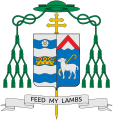English: Coat of arms of the U.S. Archbishop Eugene Antonio Marino, Archbishop of Atlanta (1988–1990).
The entire "achievement," or coat of arms as it is generally called, is composed of the shield with its charges, the motto and the external ornaments. As one looks at the shield the terms dexter (right) and sinister (left) must be understood contrariwise, as the shield was worn on the arm in medieval days and these terms were used in the relationship of the one bearing the shield.
The dexter impalement is given in ecclesiastical heraldry to the arms of jurisdiction; in this instance, the arms of the Archdiocese of Atlanta.
Atlanta known as the "Crossroads of the South," because of converging railroads which gave the city its early prominence, received its name as the eastern terminus of the Western and Atlantic Railroad which connected north Georgia with the Tennessee River. Originally called Whitehall, then Terminus, and afterwards in 1843 Marthasville, the state legislature finally acquiesced to the wishes of the railroad and accepted the name of Atlanta in 1847, thus naming the city indirectly after the Atlantic Ocean.
The Atlantic Ocean is represented on the shield of the archdiocese by white and blue wavy bars, the heraldic equivalent of the waves of the sea; seven bars in number to symbolize the Seven Sacraments.
The crown of Christ the King denotes the title of the cathedral church, the Eternal King whose redeeming Sacrifice on the Cross is renewed daily in the Holy Sacrifice of the Mass. Above the crown is placed the Cherokee rose, the State flower of Georgia (Rosa Laevigata), as befits an archdiocese located in the Capital City. The Cherokee rose is a white flower with a yellow center.
The crown of Christ the King, in the arms of the Archdiocese of Atlanta, also has the secondary representation of the crown of King George II of England after whom Georgia was named. The blue and white wavy bands may be said as well to symbolize the rolling foothills of the Blue Ridge country; but, more important, these are the colors of our Blessed Mother.
The sinister impalement, on the right of the viewer, bears the personal arms of Archbishop Marino. These consist of a blue shield with a lamb in a walking position supporting with its right foreleg a gold pastoral staff. The chief or upper portion of the shield is silver with a wavy line separating the upper and lower portions. A red chevron is superimposed on the upper portion.
The lamb has an honored and ancient history in Christian art as a symbol of Christ and the Eucharist as well as being the object of the shepherd's care.
In this instance, the lamb is supporting a pastoral staff by which Archbishop Marino wishes to emphasize the strength which comes from the unity of the pastor with those committed to his care. The lamb recalls the words of Christ to Simon Peter: "Feed my lambs," as recorded by John the Evangelist in his Gospel chapter 21, verse 15, and selected by Archbishop Marino as his episcopal motto. The lamb also recalls the archbishop's paternal heritage for it is the chief element on the Great Seal of the Commonwealth of Puerto Rico.
The wavy chief, upper portion, symbolic of water, both scripturally and sacramentally recalls the necessity of washing, cleansing and giving of life to those who would live in Christ. It also represents the archbishop's native state of Mississippi, "The Father of Waters," and acknowledges his maternal heritage and birthplace.
It is an established custom in ecclesiastical heraldry for members of religious orders who are raised to the episcopate to display the arms of their community, or part of it, in their episcopal arms. In keeping with this custom, the archbishop, a member of the Society of Saint Joseph and the Sacred Heart (Jospehites), selected the carpenter's square as a chevron from the arms of the community. It is tinctured red in honor of the Sacred Heart.
The blue field of the archbishop's shield honors the Blessed Virgin Mary. It also is found in the arms of the Josephite community.
Behind the arms is placed a gold archiepiscopal cross with double traverse. Surrounding the shield or "achievement," is a pontifical hat with ten tassels on each side in four rows, all in green.
Prior to 1870, the pontifical hat was worn in solemn conclaves held in conjunction with papal functions. The color of the pontifical hat and the number and color of the tassels were signs of the rank of a prelate, a custom which is still preserved in ecclesiastical heraldry.
Reference:




 French
French Deutsch
Deutsch